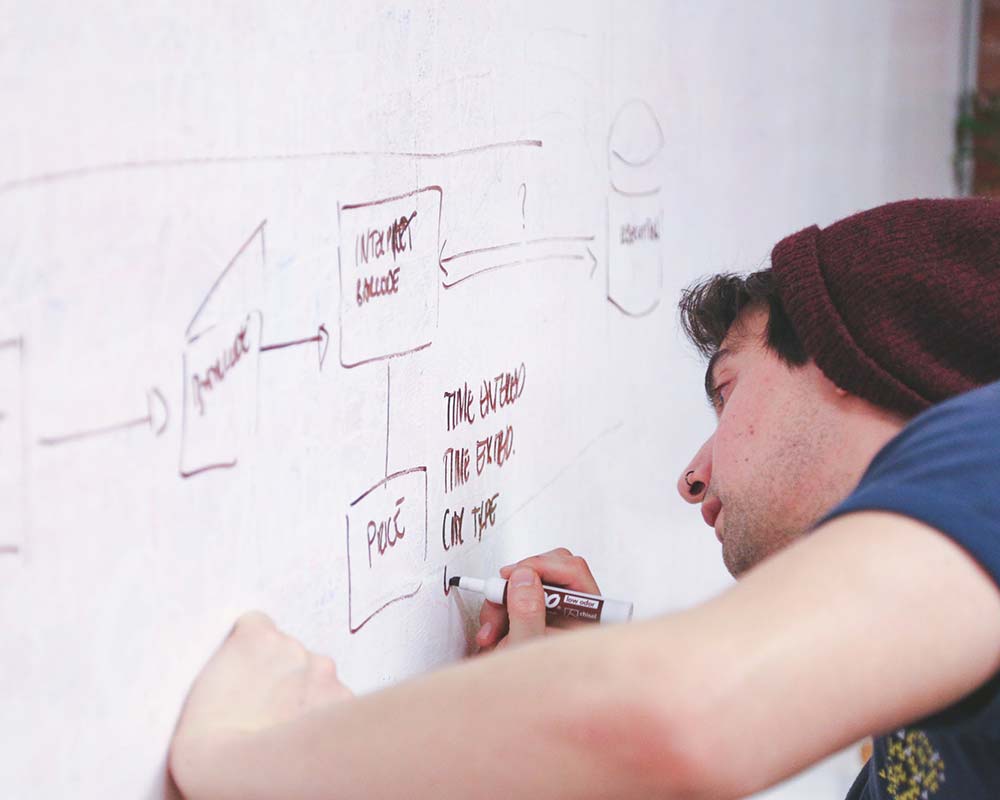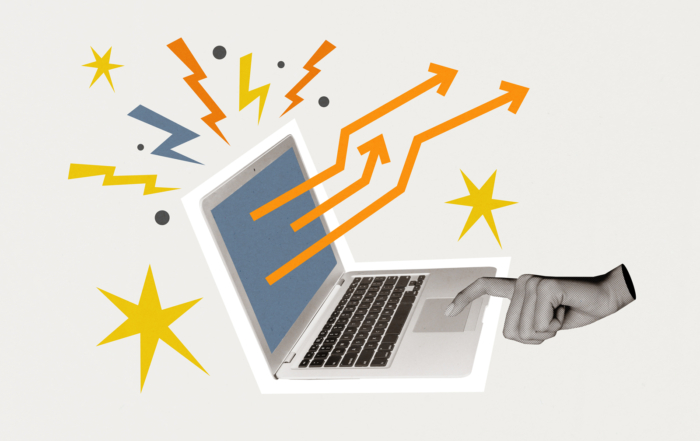Why human-centered design?

Written by: Hayden Lausell, Marketing & Creative Writing

Thinking About the Right Approach for Your Products or Services
There are many ways to go about designing a product that could revolutionize your industry. Still, the design process is essential when it comes to how successful your product will be. A new product must be easily used and understood for consumers to enjoy it, leading to positive press and potential growth for your business. There are many different approaches to take when designing a product or service, and the product that you envision could very well be an outside-the-box concept. However, human-centered design is an approach that could be potentially fruitful in your efforts.
What is Human-Centered Design?
Human-centered design is a design and management approach that creates solutions for existing issues by taking a human perspective every step of the way. This process often involves having a person to observe, plan, experiment, and implement solutions to solve problems. Human-centered design is not exclusive to just one industry or profession, and can be applied to anything from creating computer programs to making furniture for the home.
Your customers should be able to identify and solve problems using your product with ease. The human-centered design process focuses on the perspective of your users, rather than designing a product that looks appealing or performs effectively. You may be developing a product or service that can undoubtedly solve a problem; however, if customers aren’t able to understand the product, or use it with ease, the customer will likely look elsewhere to find a solution to their problem. Human-centered design ensures this scenario will not happen.
What Problems Does Human-Centered Design Solve?
Human-centered design emphasizes the importance of understanding the view of the user that is experiencing a problem or needs something, thus setting it apart from other problem-solving approaches. This design method will also assist in determining if the designed solution is satisfying their needs effectively or not. With human-centered design, the people experiencing a problem are the most integral part of the design phase, as designers and teams depend on the needs of these people to help create their product or service.
Developers and designers who utilize human-centered design take the human perspective in mind to make a difference to customers and other people involved in the use of these products. These developers and their companies will also try improving upon this human-centered experience by accepting feedback regarding the product or service in question.
How is it Different from UX Design?
Many people might confuse human-centered design with user experience design, or “UX.” While they may sound similar, they have two distinct meanings. Human-centered design is an approach that focuses on the human perspective through the design process. However, with user experience design, the focus is on the use of multi-sensory experiences, such as the interface on a screen where users connect with technology using their senses of sight, touch, and sound. While it is a design approach that revolves around a user’s interaction, it is not the same as human-centered design. Nevertheless, both methods will provide resources and useful aspects to users.
Examples of Human-Centered Design
Human-centered design has played a role in the design process of thousands of companies in the forms of new websites, native apps, and other varieties of technology. Whether online or physical products, companies have found their stride in developing quality products that revolve around the wants and needs of the user.
Websites
While websites have been around for nearly 30 years, they have drastically changed in ways that many people cannot imagine. One common problem that sites face is high bounce rates, meaning visitors quickly leave or “bounce” from a website after a few seconds if they are unable to find what they need promptly. A few common factors that lead to “bouncing” include poorly optimized pages, slow load times, and unappealing or outdated interfaces.
When companies or designers design websites today, they heavily prioritize on guiding the user to complete the desired objective, such as signing up for an account or making a purchase. In essence, human-centered design helps solve problems of the site visitors. Pinterest, Paypal, and Zillow are excellent examples of websites that follow this trend and have benefitted tremendously in doing so.
Initially, website designs strived to look appealing and inviting to visitors, intended to be a beautiful representation of that company. Today, however, many websites go in a different direction, designed to help visitors navigate to pages that they are most interested in viewing. This method is achieved with large, bold lettering and menus that are highly visible and clickable, so that while the website still looks modern and appealing, it is easy for visitors to carry out tasks while they are browsing the site.
Apps
Apps for computers and handheld devices work similarly to websites with minimalist interfaces and menus. In most cases, apps are more optimized for on-the-go use compared to websites that require device and browser compatibility for optimization. Although apps need users to download first, they must still help the user solve their problems quickly and efficiently.
Apps for smart devices also help customers by diminishing the need for a mouse and keyboard needed for PC use. Apps like Trello, Credit Karma, and Discord are specialty apps that quickly and efficiently complete actions, whether online or offline. There are many apps today that take the human-centered design approach, whether they are eCommerce, utility, or productivity apps, and customers enjoy their functionality and prompt performance over their design aesthetics.
Voice Assist Technology
Voice assist technology has become all the rage in today’s homes. Products like Amazon Alexa, Google Assistant, and Apple Siri are all products in which you simply ask a device, such as a hub or a speaker, a question, and it replies with an answer. What is unique about voice assist technology is that there are no screens or visuals needed for the user to understand the response. Customers love the ease of use and convenience that these voices provide. Human-centered design comes into play when a user needs help, and they immediately know how to obtain it; simply ask.
It is also possible to connect voice assist technology to other smart devices and utilities in your home. For example, lights, TVs, air conditioners, and smoke detectors are now compatible with voice assist technology. Users simply adjust the living room temperature by telling their device to do so. While the concept of voice assist technology sounds very complicated, customers can rig their smart home setups to be as straightforward or as in-depth as they please. The great thing about this technology is that it can initially be installed to serve one small purpose, and as the consumer needs, they can add more features.
Four Principles of Human-Centered Design
For business owners to better understand the intent of human-centered design, the concept is divided into four principles, focusing on the human element of your product or service. These principles are as follows:
Focus on the People
As you plan and develop your product or service, keep in mind who you are trying to assist. See theses users as human beings who depend on a company to either help solve their problems or to work towards a goal. To get a better understanding of who your product is for, understand what sort of issues your product will solve. While you would like everyone to use your product or service, focusing your marketing efforts towards a target demographic is the best strategy to guarantee that business will exceed expectations.
Choose the Right Problem to Solve
Perhaps your product or service is capable of solving more than one problem. Consider that there are two types of challenges humans face: symptoms of a problem, and the fundamental problem itself. Between these two dilemmas, companies prioritize solving fundamental problems, which will also relieve people of additional issues that root problem causes.
Finding a fundamental problem that your product can solve requires time, but regardless of how long it takes, identifying the root of a problem should be integral to the design process. If searching for problems gets overlooked, it may lead to a point in which the product will focus on the wrong issues, leading to less-than-anticipated results. The more effort put into researching, the less time and energy expended in the later stages of development and post-development.
See Everything as a System
Improving the human experience, while imperative, does not affect the overall user experience. Therefore, focusing all of your efforts on this is not recommended. It is essential to consider what you want to accomplish with your product. For instance, you may run an app in which customers can purchase goods, and while the app runs smoothly through conversion, the customer service may not be as smooth. If one major part of the user experience falters, the whole experience falters for that customer. Do not leave one part of the customer experience behind, as it can disappoint customers that rely on your company for a flawless session with your product or service.
Test Your Product Professionally
You could invest a lot of time and money in developing your service or product, but even so, you won’t know how it truly performs until real people use it. Conducting tests will do this, and the feedback you get from users will help determine what aspects of your product or service you must improve.
When conducting your tests, your subjects have to be ideal customers with problems that your product will solve. That means no family members, no team members, and no colleagues or investors, so you will need real test subjects that can give valuable analysis on your products. If you try your product out for yourself, you may easily deny that there are changes needed and will assume that your audience will share the same sentiment. However, more often than not, they will not agree. Considering this, you will need valued opinions of people you hope to sell your product or service to in the future.
The design process in human-centered design can be both cyclical and dynamic. While planning, you will notice there are several changes that your product or service may undergo to cater to more people in one way or another. For example, when your product is in a prototype or test stage, you may realize that your product does not meet the needs that you had previously laid out in earlier stages, leaving you and your team to decide on how to move forward with your concept. This scenario happens a lot with various products throughout many industries. Once your product is satisfactory to those it can benefit in the later stages of human-centered design, you will be more confident that it is a product that will find its audience upon its debut on the market.
Conclusion
Human-centered design is a concept that is used to develop any kind of product on the market today. Whether you are designing a website or a physical piece of technology, understanding the user’s point of view is crucial for the product to deliver satisfying results. You can also follow the four principles of human-centered design to ensure your product will perform as you imagine it to, from the brainstorming to the testing phases.
Contact Us
Urban Emu is an experience agency proudly driven by a singular mission: to transform the way humans live. We achieve this through a powerful fusion of design, technology, and communications, creating unparalleled online and offline experiences.
We love to hear about ideas big or small. Please don’t hesitate to get in touch with us regarding your project.
Email: hello@urbanemu.com












